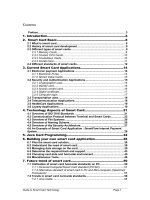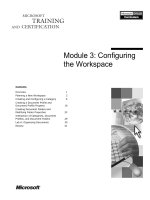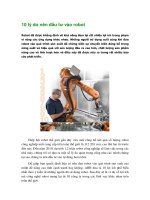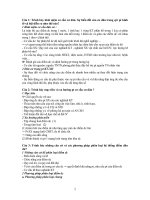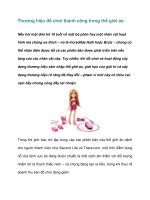Tài liệu WHO WILL DO THE SCIENCE OF THE FUTURE? docx
Bạn đang xem bản rút gọn của tài liệu. Xem và tải ngay bản đầy đủ của tài liệu tại đây (1.45 MB, 104 trang )
WHO WILL DO THE SCIENCE
OF THE FUTURE?
A SYMPOSIUM ON CAREERS OF WOMEN IN SCIENCE
NATIONAL ACADEMY OF SCIENCES
Committee on Women in Science and Engineering
Office of Scientific and Engineering Personnel
National Research Council
NATIONAL ACADEMY PRESS
Washington, D.C.
ii
NATIONAL ACADEMY PRESS • 2101 Constitution Avenue, N.W. • Washington, D.C. 20418
NOTICE: The project that is the subject of this report was approved by the Council of the National Academy of Sciences.
This report has been reviewed by persons other than the author according to procedures approved by a Report Review
Committee consisting of members of the National Academy of Sciences, the National Academy of Engineering, and the
Institute of Medicine.
This project was supported by the National Academy of Sciences. Any opinions, findings, conclusions, or recommendations
expressed in this publication are those of the author(s) and do not necessarily reflect the view of the National Academy of
Sciences.
International Standard Book Number 0-309-07185-2
Copies available from:
National Academy Press
2101 Constitution Avenue, N.W.
Box 285
Washington, D.C. 20055
(800) 624–6242, (202) 334–3313 (in the Washington Metropolitan Area)
This report is also available online at
Copyright 2000 by the National Academy of Sciences. All rights reserved.
Printed in the United States of America
The National Academy of Sciences is a private, nonprofit, self-perpetuating society of
distinguished scholars engaged in scientific and engineering research, dedicated to the
furtherance of science and technology and to their use for the general welfare. Upon the
authority of the charter granted to it by the Congress in 1863, the Academy has a mandate
that requires it to advise the federal government on scientific and technical matters. Dr.
Bruce M. Alberts is president of the National Academy of Sciences.
The National Academy of Engineering was established in 1964, under the charter of the
National Academy of Sciences, as a parallel organization of outstanding engineers. It is
autonomous in its administration and in the selection of its members, sharing with the
National Academy of Sciences the responsibility for advising the federal government. The
National Academy of Engineering also sponsors engineering programs aimed at meeting
national needs, encourages education and research, and recognizes the superior achieve-
ments of engineers. Dr. William A. Wulf is president of the National Academy of
Engineering.
The Institute of Medicine was established in 1970 by the National Academy of Sciences to
secure the services of eminent members of appropriate professions in the examination of
policy matters pertaining to the health of the public. The Institute acts under the
responsibility given to the National Academy of Sciences by its congressional charter to be
an adviser to the federal government and, upon its own initiative, to identify issues of
medical care, research, and education. Dr. Kenneth I. Shine is president of the Institute of
Medicine.
The National Research Council was organized by the National Academy of Sciences in
1916 to associate the broad community of science and technology with the Academy’s
purposes of furthering knowledge and advising the federal government. Functioning in
accordance with general policies determined by the Academy, the Council has become the
principal operating agency of both the National Academy of Sciences and the National
Academy of Engineering in providing services to the government, the public, and the
scientific and engineering communities. The Council is administered jointly by both
Academies and the Institute of Medicine. Dr. Bruce M. Alberts and Dr. William A. Wulf
are chairman and vice chairman, respectively, of the National Research Council.
National Academy of Sciences
National Academy of Engineering
Institute of Medicine
National Research Council
v
SYMPOSIUM STEERING COMMITTEE
MARYE ANNE FOX, Chair, North Carolina State University
MARGARET BURBIDGE, University of California, San Diego
MILDRED COHN, University of Pennsylvania School of Medicine
MILDRED DRESSELHAUS, Massachusetts Institute of Technology (on leave from August 2000)
MARIA NEW, Cornell University Medical College
VERA RUBIN, Carnegie Institute of Washington
KAREN UHLENBECK, University of Texas, Austin
HOWARD GEORGI, Harvard University
LILIAN WU, IBM Corporation
COMMITTEE ON WOMEN IN SCIENCE AND ENGINEERING (1999)
HOWARD GEORGI, Co-chair, Harvard University
LILIAN SHIAO-YEN WU, Co-chair, IBM Corporation
WILLIE PEARSON JR., Wake Forest University
SUSAN SOLOMON, National Oceanic and Atmospheric Administration (NOAA)
JULIA WEERTMAN, Northwestern University
OSEP ADVISORY BOARD LIAISON
STEPHEN LUKASIK, Independent Consultant
Staff
JONG-ON HAHM, Director
SHIREL SMITH, Project Coordinator
vi
OFFICE OF SCIENTIFIC AND ENGINEERING PERSONNEL ADVISORY COMMITTEE (1999)
M.R.C. GREENWOOD, Chair, University of California, Santa Cruz
DAVID BRENEMAN, University of Virginia
CARLOS GUTIERREZ, California State University, Los Angeles
STEPHEN J. LUKASIK, Independent Consultant, Los Angeles
JANET NORWOOD, The Urban Institute
JOHN D. WILEY, University of Wisconsin, Madison
TADATAKA YAMADA, Smith Kline Beecham Corporation
A. THOMAS YOUNG, North Potomac, Maryland
WILLIAM H. MILLER, ex-officio, University of California, Berkeley
Staff
CHARLOTTE V. KUH, Executive Director
MARILYN J. BAKER, Associate Executive Director
NINA KAULL, Administrative Officer
CATHY JACKSON, Administrative Associate
EDVIN HERNANDEZ, Administrative Assistant
vii
Preface
M
odern science is a complex web
of many different people and
institutions. If we are to maintain
the pace of scientific discovery for the benefit of
humankind, scientists need to ensure that
outstanding people with many different talents
will continue to join the scientific community.
Increasingly, we must compete with other
communities for the best minds the world has
to offer. If science is to continue to prosper and
move forward, we must ensure that no source
of scientific intellect is overlooked or lost. This
means including women and ethnic minorities
as active participants in the scientific enterprise.
In 1998, the National Academy of Sciences
(NAS) asked the National Research Council’s
(NRC) Committee on Women in Science and
Engineering (CWSE) to host a discussion
centered on the challenges facing all scientists in
the current scientific climate, but focused
particularly on the challenges that women face
at every transition point in their careers.
viii PREFACE
viii
Meeting participants agreed that these chal-
lenges contribute to the sharp losses in numbers
of women scientists at each career stage, and
that the NAS should make a strong statement to
focus attention on the importance of enabling
women to contribute to and lead in the
scientific process. This symposium is the
outcome of the 1998 meeting.
The symposium was held during the 1999
NAS annual meeting to address the question,
“Who will do the science of the future?” The
symposium focused on the need to bring in
many viewpoints to science and ways to
increase the variety of viewpoints by recruiting
and retaining women in science. The speakers,
all leaders in their fields, emphasized the need
to engage and sustain the interest of women in
science, and presented ways in which different
institutions have developed approaches to retain
women in scientific careers.
The Committee on Women in Science and
Engineering was honored to be asked to
organize the NAS symposium. Since its
inception in 1991 as a standing committee of
the NRC, CWSE has worked to coordinate,
monitor, and advocate national action on
increasing the numbers of women in science
and engineering. The committee members
represent diverse scientific and engineering
disciplines, and all have brought attention to
the importance of including women in their
own fields.
We would like to thank the staff of CWSE,
Dr. Jong-on Hahm, Director, and Shirel Smith,
Project Coordinator, for bringing to fruition the
ideas of the symposium steering committee and
CWSE. We would also like to thank Dr. Charlotte
Kuh, Executive Director of the Office of
Scientific and Engineering Personnel in which
CWSE is housed, for her support and guidance
to CWSE during coordination of the symposium.
Howard Georgi, Ph.D., Co-chair
Lilian Shiao-Yen Wu, Ph.D., Co-chair
Committee on Women in
Science and Engineering
ix
OVERVIEW 1
WELCOME 3
Bruce Alberts, President
National Academy of Sciences
PLENARY PANEL I: THE NEXT GENERATION: SCIENCE FOR ALL STUDENTS
Speaker Introductions 5
Marye Anne Fox (Moderator)
Chancellor, North Carolina State University
A Plan, A Strategy for K-12 7
Leon M. Lederman, Director Emeritus
Fermi National Accelerator Laboratory
Mentoring Minority Women in Science: Special Struggles 12
Richard Tapia, Professor, Computational and Applied Mathematics
Rice University
Contents
x
Controversy, The Internet, and Deformed Frogs: Making Science Accessible 16
Marcia Linn, Professor, Development and Cognition
University of California, Berkeley
PLENARY PANEL II: AN IN-DEPTH VIEW OF COMPUTER SCIENCE
Speaker Introductions 29
Marye Anne Fox (Moderator)
Chancellor, North Carolina State University
The Declining Percentage of Women in Computer Science: An Academic View 31
William A. Wulf, President
National Academy of Engineering
Women in Information Technology: A View from Industry 38
Lilian Shiao-Yen Wu
Consultant to Corporate Technical Strategy Development, IBM
President’s Committee of Advisors on Science and Technology
PLENARY PANEL III: STRATEGIES AND POLICIES TO RECRUIT, RETAIN, AND
ADVANCE WOMEN SCIENTISTS
Speaker Introductions 43
Marye Anne Fox (Moderator)
Chancellor, North Carolina State University
A Tentative Theory of Unconscious Discrimination Against Women in Science 45
Howard Georgi, Mallinckrodt Professor of Physics
Harvard University
The Mentoring Program for Women in Mathematics 49
Karen Uhlenbeck, Professor and Sid W. Richardson Foundation
Regents Chair in Mathematics
University of Texas at Austin
Strategies and Policies to Recruit, Retain, and Advance Women Scientists 55
Mildred Dresselhaus, Institute Professor
Massachusetts Institute of Technology
xi
PLENARY PANEL IV: ADVANCING WOMEN INTO SCIENCE LEADERSHIP
Speaker Introduction 57
Marye Anne Fox (Moderator)
Chancellor, North Carolina State University
Advancing Women Into Science Leadership 59
M.R.C. Greenwood, Chancellor
University of California, Santa Cruz
Closing Remarks 75
Marye Anne Fox (Moderator)
Chancellor, North Carolina State University
Question and Answer Comments
Panel I 77
Panel II 81
Panel III 84
xiii
Figures
FIGURES
1 The Frog Deformity Problem, 18
2 Lefty The Frog, 20
3 Research Forum on Deformed Frogs, 21
4 Women in Computer Science, 32
5 Computer Science Ph.D.s, 33
6 The Pipeline, 34
7 Interest in Computing, 36
8 Interest in Computing: Reason for Majoring in Computer Science, 36
9 Proportion of 24-year-olds Earning NS&E Degrees, by Country, 62
10 Nature Cover Story on Gender Differences, 64
11 Biological Sciences B.S. Degrees, 65
12 Biological Sciences Ph.D.s, 66
13 Women Biological Scientists in Academic Positions as a Percentage of Total (Men and Women), 66
14 Percentage of Women in Faculty Levels for All Science and Engineering, 67
15 Assistant Professors: Percentage of Women by Discipline, 68
16 Full Professors: Percentage of Women by Discipline, 68
17 Percentage of Women Scientists (Ph.D.s awarded pre-1969) Currently Employed in Research
I and II Institutions and Percentage of Current Female NAS Membership by Section, 70
18 Percentage of Women Biological Scientists Employed in Different Sectors, 72
xv
WHO WILL DO THE SCIENCE OF THE FUTURE?
1
Overview
Marye Anne Fox (Moderator)
Chancellor, North Carolina State University
W
elcome to a very important
symposium entitled, “Who Will
Do the Science of the Future? A
Symposium on Careers of Women in Science.”
I am Marye Anne Fox, and I will moderate
the discussion today. I do so at the request of
the Council of the National Academy of
Sciences (NAS) on which I currently serve as a
member.
Every year at the annual meeting the women
members of the NAS get together to discuss
issues facing members of groups under-
represented in the Academy’s membership.
Unfortunately, that meeting is quite small. So,
we are very pleased today to welcome to this
session a larger group, including both our
colleagues in the NAS and many other guests.
All of us in the National Academy of Sciences
thank you sincerely for being here.
It is striking that if you look at university
populations today, compared with the nation’s
demographic distribution, you will find
2 WHO WILL DO THE SCIENCE OF THE FUTURE?
2
significant differences between the student body
and the general population. In particular, these
differences are quite evident by race and ethnic
group. If you continue the same exercise to
other university groups, moving from students
through the faculty and through the adminis-
trative leadership you will find that these
differences become ever more obvious.
Think, for example, about various academic
groupings, first the students, then the faculty,
then the tenured faculty, then chaired profes-
sors, then the upper administration, and then
members of the National Academies of Sciences
and Engineering. You find a group distribution
that is increasingly white and increasingly male.
And, significantly, these distortions have
persisted despite more than three decades of
people of goodwill working hard at opening
access and opportunity to all.
To look at the academic future, one should
focus on the graduate student population.
Although this group has traditionally been
dominated by white males, you will find fewer
white males in the current group than was true
20 years ago, since there are increasingly
numbers of foreign nationals, as well as more
women and members of ethnic and racial
groups. Fewer native-born men are pursuing
graduate degrees in science and engineering.
Hence the question, the title of the seminar,
“Who Will Do the Science of the Future?” at a
time when the demographic trends in this
nation predict native-born white males to be a
minority group in the very near future.
In that context, our program incorporates
three panels of presentations: one focusing on
the next generation, Science for All Students; a
second that looks in depth at the issues reflected
in one particular field of science, computer
science, reflecting an in-depth view of academic
and industrial computer scientists; and a third
that focuses on strategies and policies to recruit,
retain, and promote career advancement for
women scientists. Finally, we will have a plenary
address on how to ensure women continue to
advance into positions of leadership in science.
We will begin with remarks from Dr. Bruce
Alberts, the President of the National Academy
of Sciences and Chair of the National Research
Council, the principal operating arm of the
National Academies of Sciences and Engineer-
ing. Dr. Alberts is a respected biochemist,
recognized for his work in biochemistry and
molecular biology. He is noted particularly for
his extensive study of protein complexes that
allow chromosomes to be replicated as required
for a living cell to divide. In addition, he is the
principal author of “The Molecular Biology of
the Cell,” which is considered the leading
textbook in its field, and is widely used in
colleges and universities here and abroad.
Dr. Alberts has long been committed to the
improvement of science education, having
dedicated much of his time to educational
projects such as City Science, a program seeking
to improve science teaching in San Francisco
elementary schools. He has served on the
Advisory Board of The National Sciences
Resource Center, a joint project of the National
Academy of Sciences and the Smithsonian
Institution, that works with teachers, students,
and school systems to improve the teaching of
science, as well as on the National Academy of
Sciences’ Committee on Science Education,
Standards and Assessments.
3
Welcome
Bruce Alberts, President
National Academy of Sciences
I
would like to thank the Steering Committee
and Marye Anne for organizing this
symposium. This is the first time that we
have ever had such an event at our annual
meeting.
The members of the Steering Committee, in
addition to Marye Anne Fox were Margaret
Burbidge, Mildred Cohn, Millie Dresselhaus,
Maria New, Vera Rubin, and Karen Uhlenbeck.
We also need to thank the co-chairs of our
Committee on Women in Science and Engi-
neering, Lilian Wu and Howard Georgi. I’m
very appreciative of their continued efforts on
this important issue.
We all recognize that science is, and must be,
an elitist enterprise. It needs our very best
minds. Unfortunately, we turn many, probably
most, of those potential scientists away from
science at an early age. When we do so, we are
shortchanging both science and our nation.
To date, science has never really looked like
America. It has always been carried out
4 WHO WILL DO THE SCIENCE OF THE FUTURE?
4
predominantly by white males. But included are
immigrants from all over the world participating
in science. Therefore, no matter where talent
arises, our enterprise recognizes it without
regard to the culture or the country of origin of
the individual.
Science is a merit-based enterprise. How do
we bring more people into this enterprise? It is
very important that we do so for many reasons.
One often talks about the unfairness of not
giving everybody a chance to contribute. But an
even bigger issue in this country, as it becomes
more and more diverse, is that a science
establishment run primarily by white males
runs the danger of alienating our nation and
our people from science.
In my field of biology, my university, the
University of California, San Francisco (UCSF)
has been competing with MIT for the very best
graduate students in the nation. For at least 10
years now, over half of these graduate students
have been women.
In biology, women are doing very well as
undergraduates and in graduate school. We
need to understand what follows afterward.
This is an important issue that could be
scientifically studied.
Our symposium today is designed to
encourage discussion about the efforts that
are being made by some of our very best
scientists to bring more diversity to science at
all levels, and you will hear about some
important ideas.
As you heard, the Academy has a committee
that is being informed by this symposium today
and will be empowered by it. In the process of
working on this issue, we want to make science
appear to everyone as what it truly is: a
wonderful enterprise, a worldwide enterprise in
which anyone with talent, ambition, and
interest can participate. If we do that, science
will have a much larger role, both in this nation
and the world.
5
Plenary
Panel I:
The Next
Generation:
Science for All
Students
SPEAKER INTRODUCTIONS
Marye Anne Fox (Moderator)
Chancellor, North Carolina State University
T
he first panel of our program will
focus on the next generation of
scientists, “Science for All Students.”
We have three panelists participating in this
discussion: Drs. Leon Lederman, Richard Tapia,
and Marcia Linn.
Dr. Lederman is an internationally renowned
high-energy physicist, the Director Emeritus of
Fermi National Accelerator Laboratory in
Batavia, Illinois. He holds an appointment as
the Pritzker Professor of Science at Illinois
Institute of Technology in Chicago.
Dr. Lederman served as Chairman of the
State of Illinois’ Governor’s Science Advisory
Committee, and he is the founder and resident
scholar at the Illinois Mathematics and Science
Academy, a three-year residential public high
school for the gifted. Dr. Lederman was
Director of the Fermi Laboratory from 1979 to
1989, and is a founder and Chairman of the
Teachers’ Academy for Mathematics and
Science. In 1990, he was elected President of the
6 WHO WILL DO THE SCIENCE OF THE FUTURE?
6
American Association for the Advancement of
Science. He served as a founding member of the
High-Energy Physics Advisory Board of the
United States Department of Energy and on the
International Committee for Future Accelerators,
the largest organization of that type in the
United States. He is a member of the National
Academy of Sciences and has received numer-
ous awards, including the National Medal of
Science, the Elliott Cresson Medal of the
Franklin Institute, the Wolf Prize in Physics,
and the Nobel Prize in Physics.
Dr. Richard Tapia is a strong advocate for
minorities and women in the sciences and
mathematics, and is a professor in the Depart-
ment of Computational and Applied Math-
ematics at Rice University in Houston.
In addition to being the first in his family to
attend college, Dr. Tapia is also the first native-
born Hispanic American to be inducted into
the National Academy of Engineering. Inter-
nationally known for his research and work in
computational and mathematical science, he
was appointed by President William Clinton to
the National Science Board in 1996. Recently,
Dr. Tapia became the co-editor for all educa-
tional outreach programs for the nation’s two
supercomputer centers in San Diego and the
University of Illinois.
Dr. Marcia Linn is a Professor of Develop-
ment and Cognition and of Education in
Mathematics, Science and Technology in the
Graduate School of Education at the University
of California at Berkeley.
A fellow of the American Association for the
Advancement of Sciences, she researches the
teaching and learning of science and technology,
gender equity and the design of technological
learning environments. In 1998, the Council of
Scientific Society Presidents selected her for its
first award in educational research. From 1995
to 1996, she was a fellow at the Center for
Advanced Study in Behavioral Sciences, and in
1994 she received the National Association for
Research and Science Teaching Award for Life-
Long Distinguished Contributions to Science
Education.
The American Educational Research
Association bestowed on her the Willystine
Goodsell Award in 1991, and the Women
Educators Research Award in 1982. Twice she
has won the Outstanding Paper Award from the
Journal of Research in Science Teaching. She
serves on the Board of the American Association
for the Advancement of Science, the Graduate
Record Examination Board of the Educational
Testing Service, and the McDonnell Foundation
for Cognitive Studies in Education.
7
A PLAN, A STRATEGY FOR K-12
Dr. Leon M. Lederman, Director Emeritus
Fermi National Accelerator Laboratory
W
hen I was invited to come here I
said, “Well, the only thing I could
talk about is what I happen to be
doing now, and I happen to be very interested
in high schools and high school science.”
I spend a lot of time in high schools. I didn’t
know how relevant I could make that to your
topic but between that time and now I have
learned that indeed the kinds of things I am
after have a surprising relevance to the issue we
have today.
I am going to talk about a plan, a strategy for
getting into the K-12 arena in a dramatic way.
Now, again, my problem is complicated by the
fact that I am a limited observer in this field.
I tend to look at the spectrum of opinions on
science education in the country, say, ever since
the 16-year-old report, A Nation at Risk. One
can read justifiable opinions on all sides of how
well we are doing.
My own feeling is more pessimistic. In spite
of the expenditure of many hundreds of
8 WHO WILL DO THE SCIENCE OF THE FUTURE?
8
millions of dollars invested in science education
reform and efforts of many, many smart people,
we have very little to show for it.
It is not that we don’t have anything to show
for it. We certainly have a keen awareness now
of the importance of science. Most dramati-
cally, in spite of the obsessive belief in local
deployment of education, we have a consensus
of national standards in math and science that
are being adopted by many states. The National
Academies played an important role in this
crucial development.
We are interested in a dramatic reform of
high school science education, designed to
change the way science is taught in 99 percent
of U.S. high schools. We also want to breach
the wall of resistance to change that seems to
surround our educational system, and like any
military strategist, once you enter that breach
you spread out and begin to make the changes
appropriate for the 21st century.
I call it TYNT because most teachers, when
you talk to them about reform, will say, “Oh, oh,
that is This Year’s New Thing.” You have to face
the fact that schools are bombarded with “This
Year’s New Things.” Of course, my year’s new
thing is going to be different from all other
“This Year’s New Things.”
We call it the “American Renaissance In
Science Education,” or ARISE, and I like the
word “renaissance.” It is carefully chosen.
Three happenings make things encouraging.
One is the new science standards. These
standards require a minimum of three years of
science in the grade 9-12 program. Four is
better, if you want to reach and exceed the
standards. Then we have the problem of the
international tests like the Third International
Mathematics & Science Study (TIMSS) 1998
and other assessments that tell us that we have a
long way to go before we can be satisfied with
our educational system. The poor performance
of our students cries out for reform.
Finally, the time is appropriate to make
serious changes in education, which has
become known as “dot edu.” The President of
the United States says that improving education
is the most important thing we can do in the
nation and this is clearly an unimpeachable
source.
We have about 16,000 school districts in this
country, all going in their own different
directions. About 50 percent of these schools
insist on more than one year of science. Only
20 percent insist on three years of science, but
there is a trend now to increasing the science
required as states begin to take on the problem
of establishing standards. Many, if not most,
states are aligning their standards pretty nearly
with the national consensus standards written
by the Academies and by the American Associa-
tion for the Advancement of Science.
I think we see a good trend of increasing the
science requirement. ARISE proposes to create
a coherent three-year curriculum. That is, once
you have a three-year science requirement, you
may as well make it a core curriculum and let it
hang together. We use the word “coherent” and
“core curriculum” because we want to show
that there is a logical order to the disciplines
and strong connecting links.
If you look at the mathematical metaphor,
you study addition, and then you study
subtraction, and you study lots of things in
mathematics, but you never forget addition
because you keep using it. It isn’t a question of
